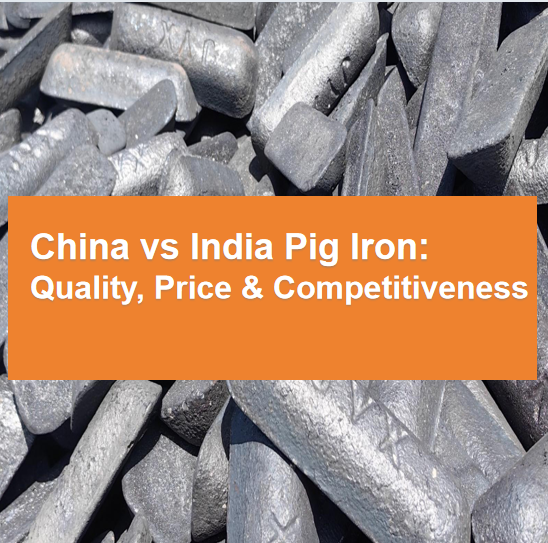China vs India Pig Iron: Quality, Price & Competitiveness
2025-08-04 16:05:54 hits:0
In the global steel industry landscape, China and India, as two major emerging economies, have always been core players that cannot be ignored. As the "cornerstone" of the steel industry chain, the production capacity, technological level, and market performance of pig iron in both countries not only affect the rise and fall of their respective industries but also profoundly shape the global steel market pattern. Today, we take "Indian pig iron vs Chinese pig iron" as a starting point to explore this steel rivalry spanning the Himalayas.
1. Resource Endowments: Iron Ore Reserves & Cost Advantages
The production of pig iron always starts with iron ore, the core raw material. In this regard, India seems to hold a "heaven-sent script" — its iron ore reserves rank among the world’s top, with most being high-grade rich ores. This not only reduces mining costs but also directly lowers the pressure of impurity treatment in the ironmaking process. This "proximity to resources" advantage has given Indian pig iron an early edge in cost competition and become a key driver for its steel industry development in recent years.
In contrast, although China has large total iron ore reserves, the proportion of high-grade ores is low. It relies heavily on imports from Australia, Brazil, and other countries each year, leading to high external dependence on raw materials. This means Chinese pig iron production faces risks from fluctuations in international ore prices from the very beginning, making cost control more challenging. However, China has compensated for this resource disadvantage through decades of industrial accumulation — by global resource layout, optimizing import channels, and technological innovations to reduce unit ore consumption, it has firmly secured the position of the world’s largest pig iron producer despite "innate deficiencies."
2. Production Technologies: Blast Furnace Processes, Energy & Efficiency
If resources are the "innate genes," then technology and efficiency are the keys to "acquired development." In this aspect, the gap between the two countries is evident.
India’s pig iron industry has made progress in recent years, but its overall technological level remains backward. Some small and medium-sized steel enterprises use outdated blast furnace equipment with low automation, resulting in low production efficiency, high energy consumption, and severe pollution. Data shows that India’s average energy consumption per ton of pig iron is 10%-15% higher than the international advanced level, which undoubtedly weakens its cost advantage in the context of rising energy prices.
China, on the other hand, has long entered the "intelligent era" of pig iron production. Large steel enterprises widely adopt advanced technologies such as large blast furnaces (over 5,000 cubic meters), coal injection, and waste heat recovery systems. These not only reduce the comprehensive energy consumption per ton of pig iron to world-leading levels but also achieve stable improvement in product quality through precise control of the smelting process. Leading enterprises like Baosteel and Angang can even produce high-purity pig iron meeting the strict requirements of high-end automotive sheets, nuclear power steel, and other fields, forming a solid technological barrier.
3. Market Competitiveness: Price, Quality & Export Strengths
The differences in resources and technologies are ultimately reflected in the "report card" of market competition.
Indian pig iron, relying on resource cost advantages, focuses on the "cost-performance card" in the international market, particularly in price-sensitive regions such as Southeast Asia and the Middle East. However, its product quality lacks stability — some small and medium-sized enterprises produce pig iron with high sulfur, phosphorus, and other impurities, making it difficult to meet the requirements of high-end manufacturing. This has prevented Indian pig iron from breaking into the high-end market.
Chinese pig iron has taken the path of "quality first." Through strict production standards and full-process quality control, Chinese pig iron not only has low impurity content and uniform composition but also can customize products of different grades according to customer needs. This dual advantage of "high quality + large scale" has made Chinese pig iron dominant in the global mid-to-high-end market, with export destinations including Japan, South Korea, Europe, and other regions with strict quality requirements. Despite higher raw material costs, Chinese pig iron maintains strong market competitiveness relying on technological premiums and brand recognition.
4. Future Trends: Green Transformation & Tech Innovation
With the advancement of global "dual carbon" goals, the green transformation of the steel industry has become an inevitable trend, opening a new track for the competition between Chinese and Indian pig iron.
India plans to reduce carbon emissions from pig iron production by introducing advanced environmental protection technologies and eliminating backward production capacity. However, issues such as industrial fragmentation and insufficient capital investment may slow down its transformation. China, on the other hand, has long included "green ironmaking" in its core industrial upgrading goals — cutting-edge technologies such as hydrogen metallurgy and carbon capture are being rapidly developed and applied. Some enterprises have achieved ultra-low emission transformation and even explored clean energy models like "photovoltaics + ironmaking." This "green first-mover advantage" may become a key chip for China to consolidate its global position in pig iron production in the future.
Meanwhile, India is striving to narrow the technological gap by attracting foreign investment and supporting domestic R&D, attempting to gain a share in the mid-to-high-end pig iron market. China, however, is aiming higher — promoting deep integration of pig iron production with the digital economy, optimizing the entire production process through industrial internet and artificial intelligence to further widen the gap with competitors.
Conclusion: Industrial Upgrading Insights Behind the Rivalry
The comparison between Indian and Chinese pig iron is never a simple "superiority or inferiority" debate but reflects the different explorations of two developing countries on the path of steel industry upgrading. India’s resource advantages and cost potential deserve attention, while China’s technological accumulation and green transformation experience also provide valuable lessons.

In the future, as the global steel market evolves, this rivalry may intensify. However, the ultimate winner will surely be the country that can balance resources, technology, environmental protection, and market demand. For us, understanding this rivalry not only helps grasp global steel industry trends but also reveals the positioning and future of "Made in China" and "Made in India" in the global industrial chain.
About Us: Authorized Agent for Top Chinese Pig Iron Brands, Favorable Prices
As a seasoned player in China’s pig iron sector, Tiegu has always been committed to providing high-quality Chinese pig iron products to global customers. Currently, we act as an authorized distributor for various domestic pig iron brands in China, covering the full range of pig iron products from industry-leading enterprises such as Huangshi Xinxing Pig Iron, Guoming Pig Iron, Juyixing Pig Iron, Shandong Rizhao Zhufu Pig Iron, and Tianlong Pig Iron.
Leveraging our core advantage as a first-class agent, we not only ensure stable supply and high-quality standards but also pass on tangible price benefits to customers by eliminating intermediate links. Whether you are engaged in steel deep processing, machinery manufacturing, or infrastructure projects, we can match cost-effective product solutions tailored to your specific needs.

 en
en  fra
fra  de
de  ru
ru  ara
ara  gle
gle  it
it  jp
jp  kor
kor  th
th  zh
zh 


